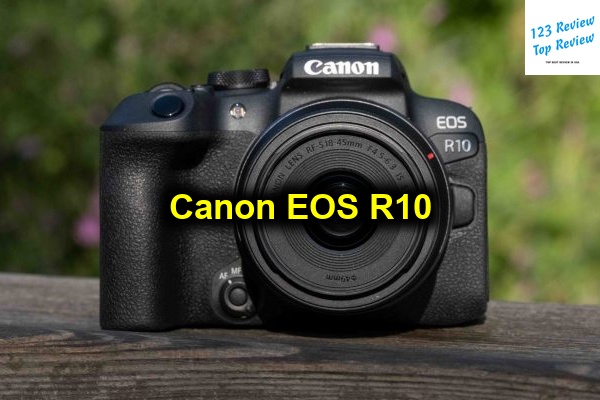The Canon EOS R10 is a noteworthy addition to the growing ecosystem of Canon’s mirrorless cameras. Designed to cater to both photography enthusiasts and aspiring videographers, the R10 heralds a new era in the APS-C sensor format with its compact design, cutting-edge technology, and user-friendly features.

In this article, 123 Review explores the EOS R10 in its entirety, examining everything from design to performance, highlighting why it may be the ideal choice for many photographers looking to make the leap into the mirrorless world.
Design and Build Quality
Dimensions and Weight
The Canon EOS R10 is designed with portability in mind. It weighs just around 429 grams (approximately 0.94 pounds) including battery and memory card, making it an ideal companion for travel and on-the-go photography. Its dimensions—122.5 x 87.8 x 83.4 mm (4.82 x 3.46 x 3.28 inches)—reflect a dedication to keeping the camera as compact as possible without sacrificing usability. This lightweight and portable design is perfect for those who need to carry their camera for long periods, whether exploring urban landscapes or hiking through the wilderness.
Materials Used
Canon has utilized high-quality polycarbonate and magnesium alloy in constructing the EOS R10, ensuring a balance between weight reduction and durability. The inclusion of metal elements adds a sturdiness that assures users of the camera’s ability to withstand everyday wear and tear. While the R10 doesn’t feature full weather sealing, it’s robust enough for typical use, making it a reliable choice for a wide range of shooting conditions.
Usability and Handling
The EOS R10’s ergonomic design is crafted for comfortable handling, featuring a well-contoured grip that feels natural in the hand. This design attributes ensure that the camera is stable and easy to maneuver, which is essential when working in dynamic or spontaneous environments. The button placement is intuitive, providing easy access to essential functions and settings, thereby minimizing the need to delve into menus. The overall design encourages a smooth shooting experience, promoting confidence in capturing high-quality images efficiently.
Image Quality
Sensor Performance
The Canon EOS R10 is equipped with a 24.2-megapixel APS-C CMOS sensor that greatly enhances image quality. This sensor provides excellent resolution for capturing fine details, whether photographing landscapes or close-up subjects. Paired with the DIGIC X processor, the R10 offers rapid image processing and superior noise reduction, even at higher ISOs. This blend ensures crisply detailed images with vibrant colors, making it a standout competitor in its class.
Dynamic Range
Dynamic range is an area where the EOS R10 excels, offering the depth necessary to capture scenes with complex lighting. The sensor’s capability to retain detail in both the darkest shadows and the brightest highlights is impressive, allowing photographers to push the boundaries of their creative expression. This feature is especially beneficial when shooting in environments with high contrast, such as sunny outdoor scenes or dimly lit interiors.
Color Accuracy and Rendering
Canon’s reputation for exceptional color science is well-deserved, and the EOS R10 continues this tradition with precise color accuracy and rendering. The camera produces images with vibrant, true-to-life colors that reduce the need for post-processing adjustments. Whether capturing the subtle hues of a sunset or the vivid colors of a street market, the R10’s color rendition enhances the storytelling quality of each photograph.
Autofocus System
Dual Pixel CMOS II Technology
The Canon EOS R10 features the advanced Dual Pixel CMOS II autofocus technology, which is renowned for its speed and precision. This system ensures rapid autofocus across a wide area of the frame, enhancing the photographer’s ability to quickly lock onto subjects. The Dual Pixel system provides a seamless and fluid shooting experience, especially when tracking fast-moving or erratic subjects—an essential feature for sports and wildlife photographers.
Focus Tracking Capabilities
Focus tracking capabilities on the EOS R10 are enhanced by subject detection algorithms that utilize deep learning for improved performance. The system can recognize and track subjects accurately, maintaining focus as they move across the frame. This functionality is invaluable for capturing sharp, focused shots in dynamic scenes, such as children at play, wildlife, or live events, where unpredictable movement is common.
Low Light Autofocus Performance
The R10’s autofocus system performs admirably in low-light conditions, a critical aspect for photographers who frequently work indoors or shoot during twilight hours. The camera’s capability to achieve focus in dim conditions is facilitated by its sensitive AF system and intelligent algorithms that work to minimize focus hunting, ensuring subjects remain clear even in challenging light.
Shooting Features
Burst Shooting Rates
With its impressive burst shooting rates, the Canon EOS R10 can capture 15 frames per second (fps) using the mechanical shutter and up to 23 fps with the electronic shutter. This rapid firing capability allows photographers to seize action sequences with precision, ensuring that crucial moments are not missed. Sports and action photographers will find this especially valuable when they need to capture the perfect moment amid rapid movement.
Video Capabilities
For videographers, the Canon EOS R10 offers robust video capabilities, with support for 4K UHD recording up to 60p. The camera also supports high-frame-rate Full HD recording up to 120p, which is perfect for producing smooth, cinematic slow-motion footage. Canon Log 3 and HDR PQ recording options provide enhanced dynamic range and flexibility in post-production, allowing videographers to achieve a professional quality in their work.
Raw and JPEG Performance
The EOS R10 excels in delivering first-rate photo formats with both RAW and JPEG options. Photographers have the benefit of capturing RAW files for maximum editing capability in post-production, while JPEGs are ideal for large-volume shooting and immediate sharing. The images produced in both formats maintain high levels of detail and color accuracy, making the R10 versatile for various photographic projects and outputs.
User Interface
Controls and Dials
Canon has designed the EOS R10 with a user-friendly layout, featuring strategically positioned controls and dials for a seamless photography experience. The camera includes a multi-function dial and a joystick for quick adjustments, allowing users to modify settings without interrupting their shooting flow. The placement and tactile feel of these controls are designed to cater to both novice users and seasoned professionals who require speed and precision.
Menu Navigation
The Canon EOS R10 boasts a logically organized menu system designed to enhance ease of navigation. The clear structure and intuitive organization make it easier for users to find and adjust settings quickly. The inclusion of a customizable My Menu tab allows photographers to store frequently accessed settings, further enhancing efficiency and personalization.
Touchscreen Functionality
A standout feature of the EOS R10 is its 3-inch vari-angle touchscreen, which provides a fluid and responsive user interface. This touchscreen supports touch navigation for focus point selection, menu access, and image review, making it an invaluable tool for photographers accustomed to modern touch-based interfaces. Its ability to tilt and rotate adds versatility to framing compositions from unconventional angles, whether shooting high above a crowd or low to the ground.
Battery Life and Performance
Battery Specifications
The Canon EOS R10 is powered by the LP-E17 battery, which is standard within Canon’s line of compacts and mid-range cameras. This battery offers approximately 450 shots per charge under CIPA standards, sufficient for most daily shooting needs. Its compatibility with existing Canon battery chargers adds convenience for users already within the ecosystem.
Real-World Usage
In real-world scenarios, the battery life of the EOS R10 performs admirably, sustaining a full day of shooting with moderate usage. Power management is efficient, minimizing energy consumption even during high-demand activities such as extended burst shooting or continuous video recording. For extended sessions, carrying a spare battery or employing the camera’s USB charging capability ensures uninterrupted performance.
Connectivity Options
Wireless Features
The Canon EOS R10 embraces modern connectivity with built-in Wi-Fi and Bluetooth capabilities. These wireless options enable seamless image transfer to smartphones and tablets via the Canon Camera Connect app, supporting quick sharing and remote camera operation. This connectivity is essential for photographers and creators who require instant access and distribution of their images across social media platforms or professional applications.
Port Availability
The camera is equipped with a variety of ports to support diverse connectivity and peripheral interactions. These include a USB-C port for fast data transfers and charging, a micro HDMI port for high-definition video output, and 3.5mm microphone input for enhanced audio recording capabilities. The comprehensive port selection ensures that photographers and videographers can easily integrate the R10 into more advanced setups.
Lens Compatibility
Available RF-S Lenses
The Canon EOS R10 utilizes the RF mount, providing access to a burgeoning collection of RF-S lenses tailored for APS-C sensors. This lineup includes versatile zooms and primes that offer exceptional optical quality, allowing photographers to maximize their creative potential with a lightweight, compact system. Moreover, Canon’s commitment to expanding the RF lens range ensures continued access to innovative optical technology.
Adapting EF and EF-S Lenses
Thanks to the EF-EOS R mount adapter, the EOS R10 is fully compatible with Canon’s extensive range of EF and EF-S lenses. This adaptability provides users with an incredible selection of lenses, from specialized optics to classic favorites, without sacrificing performance or quality. The seamless integration between these lenses and the EOS R10 ensures that photographers transitioning from other Canon systems can continue using their preferred glass.
Comparison with Competitors
Canon EOS R50 vs R10
The Canon EOS R10 and R50 cater to different audiences within the APS-C mirrorless market. The R10 offers more advanced features for enthusiast photographers, including higher burst rates and better video functionalities. Meanwhile, the R50 is positioned as a beginner-friendly model with simplified controls and a slightly smaller form factor, making it ideal for new users entering the Canon ecosystem.
Alternatives in the APS-C Segment
In the competitive APS-C landscape, the Canon EOS R10 contends with models like the Sony a6400 and Fujifilm X-T30 II. Canon stands out with its superior autofocus system, comprehensive connectivity options, and expansive lens adaptability. While Sony may offer similar AF speed, and Fujifilm provides renowned color profiles, the R10’s combination of ease of use, feature set, and price point offers strong comparative advantages.
Price-Benefit Analysis
Within its category, the EOS R10 is competitively priced, delivering exceptional value through its feature-rich offerings. Its capabilities align closely with both all-purpose and specialized photography needs, providing the advanced functionality typically sought by photographers without the premium cost often associated with professional models. This balance makes the R10 an attractive investment for those serious about advancing their skills without overextending their budget.
Pros and Cons
Highlights of the R10
- Advanced Autofocus: Dual Pixel CMOS II offers superior speed and subject tracking.
- Robust Shooting Rates: Fast burst speeds make it ideal for capturing rapid action.
- High-Quality Video: Excellent 4K and slow-motion capabilities for videography.
- Ease of Use: Intuitive controls and touchscreen for seamless operation.
- Broad Lens Compatibility: Access to RF, EF, and EF-S lenses enhances flexibility.
Limitations and Drawbacks
- Limited Weather Sealing: Not fully protected against adverse conditions.
- Battery Life: Moderate lifespan may require carrying spare batteries for all-day events.
- Small Form Factor Limitations: Can be ergonomically challenging with larger lenses.
Conclusion and Recommendations
Ideal User Profile
The Canon EOS R10 is ideally suited for enthusiast photographers seeking to harness the capabilities of a modern mirrorless camera without entering the full-frame market. Its balance of portability and performance makes it an excellent choice for travelers, hobbyists, and aspiring professionals focusing on action photography, vlogging, or everyday shooting needs.
Final Thoughts
Overall, the Canon EOS R10 is a standout APS-C mirrorless camera that excels through its responsive autofocus system, impressive image quality, and extensive video functionality. Despite some limitations, its feature set offers significant value for money, underlined by Canon’s reliable build quality and expansive ecosystem. Whether you’re transitioning from a DSLR or upgrading from a beginner model, the R10 provides the tools necessary to explore and enhance your creative journey.





